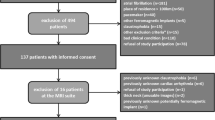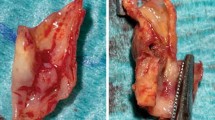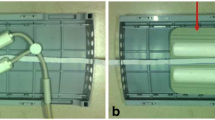Abstract
Objectives
To investigate the influence of atherosclerotic plaques on femoral haemodynamics assessed by two-dimensional (2D) phase-contrast (PC) magnetic resonance imaging (MRI) with three-directional velocity encoding.
Methods
During 1 year, patients with peripheral artery disease and an ankle brachial index <1.00 were enrolled. After institutional review board approval and written informed consent, 44 patients (age, 70 ± 12 years) underwent common femoral artery MRI. Patients with contra-indications for MRI were excluded. Sequences included 2D time-of-flight, proton-density, T1-weighted and T2-weighted MRI. Electrocardiogram (ECG)-gated 2D PC-MRI with 3D velocity encoding was acquired. A radiologist classified images in five categories. Blood flow, velocity and wall shear stress (WSS) along the vessel circumference were quantified from the PC-MRI data.
Results
The acquired images were of good quality for interpretation. There were no image quality problems related to poor ECG-gating or slice positioning. Velocities, oscillatory shear stress and total flow were similar between patients with normal arteries and wall thickening/plaque. Patients with plaques demonstrated regionally increased peak systolic WSS and enhanced WSS eccentricity.
Conclusions
Combined multi-contrast morphological imaging of the peripheral arterial wall with PC-MRI with three-directional velocity encoding is a feasible technique. Further study is needed to determine whether flow is an appropriate marker for altered endothelial cell function, vascular remodelling and plaque progression.
Key Points
• Femoral plaques are associated with altered dynamics of peripheral blood flow.
• Multi-contrast MRI can investigate the presence and type of atherosclerotic plaques.
• Three-dimensional velocity-encoding phase-contrast MRI can investigate flow and wall shear stress.
• Atherosclerotic peripheral arteries demonstrate increased systolic velocities and wall shear stress.


Similar content being viewed by others
Abbreviations
- WSS:
-
wall shear stress
- PAD:
-
peripheral arterial disease
- OSI:
-
oscillatory shear index
- TOF:
-
time-of-flight
- PD:
-
proton density
- PC:
-
phase contrast
- LR/NC:
-
lipid-rich/necrotic core
References
Roger VL, Go AS, Lloyd-Jones DM et al (2011) Heart disease and stroke statistics–2011 update: A report from the American Heart Association. Circulation 123:18
Malek AM, Alper SL, Izumo S (1999) Hemodynamic shear stress and its role in atherosclerosis. JAMA 282:2035–2042
Cecchi E, Giglioli C, Valente S et al (2011) Role of hemodynamic shear stress in cardiovascular disease. Atherosclerosis 214:249–256
Cheng C, Tempel D, van Haperen R et al (2006) Atherosclerotic lesion size and vulnerability are determined by patterns of fluid shear stress. Circulation 113:2744–2753
van Bochove GS, Straathof R, Krams R, Nicolay K, Strijkers GJ (2010) MRI-determined carotid artery flow velocities and wall shear stress in a mouse model of vulnerable and stable atherosclerotic plaque. MAGMA 23:77–84
Lawrence-Brown M, Stanley BM, Sun Z, Semmens JB, Liffman K (2011) Stress and strain behaviour modelling of the carotid bifurcation. ANZ J Surg 81:810–816
Papafaklis MI, Koskinas KC, Chatzizisis YS, Stone PH, Feldman CL (2010) In-vivo assessment of the natural history of coronary atherosclerosis: Vascular remodeling and endothelial shear stress determine the complexity of atherosclerotic disease progression. Curr Opin Cardiol 25:627–638
Wang C, Chen M, Liu S-L, Liu Y, Jin J-M, Zhang Y-H (2013) Spatial distribution of wall shear stress in common carotid artery by color doppler flow imaging. J Digit Imaging 26:466–471
Zhang C, Xie S, Li S et al (2012) Flow patterns and wall shear stress distribution in human internal carotid arteries: The geometric effect on the risk for stenoses. J Biomech 45:83–89
Keeling AN, Carroll TJ, McDermott MM et al (2012) Clinical correlates of size and number of collateral vessels in peripheral artery disease. Vasc Med 17:223–230
McDermott MM, Liu K, Carroll TJ et al (2011) Superficial femoral artery plaque and functional performance in peripheral arterial disease: walking and leg circulation study (WALCS III). JACC Cardiovasc Imaging 4:730–739
McDermott MM, Criqui MH, Liu K et al (2000) Lower ankle/brachial index, as calculated by averaging the dorsalis pedis and posterior tibial arterial pressures, and association with leg functioning in peripheral arterial disease. J Vasc Surg 32:1164–1171
Cai J-M, Hatsukami TS, Ferguson MS, Small R, Polissar NL, Yuan C (2002) Classification of human carotid atherosclerotic lesions with in vivo multicontrast magnetic resonance imaging. Circulation 106:1368–1373
Saam T, Ferguson MS, Yarnykh VL et al (2005) Quantitative evaluation of carotid plaque composition by in vivo MRI. Arterioscler Thromb Vasc Biol 25:234–239
Caro CG (2009) Discovery of the role of wall shear in atherosclerosis. Arterioscler Thromb Vasc Biol 29:158–161
Ku DN, Giddens DP, Zarins CK, Glagov S (1985) Pulsatile flow and atherosclerosis in the human carotid bifurcation. Positive correlation between plaque location and low oscillating shear stress. Arterioscler Thromb Vasc Biol 5:293–302
Zarins CK, Giddens DP, Bharadvaj BK, Sottiurai VS, Mabon RF, Glagov S (1983) Carotid bifurcation atherosclerosis. Quantitative correlation of plaque localization with flow velocity profiles and wall shear stress. Circ Res 53:502–514
Wentzel JJ, Chatzizisis YS, Gijsen FJH, Giannoglou GD, Feldman CL, Stone PH (2012) Endothelial shear stress in the evolution of coronary atherosclerotic plaque and vascular remodelling: current understanding and remaining questions. Cardiovasc Res 96:234–243
Katritsis D, Kaiktsis L, Chaniotis A, Pantos J, Efstathopoulos EP, Marmarelis V (2007) Wall shear stress: Theoretical considerations and methods of measurement. Prog Cardiovasc Dis 49:307–329
Frydrychowicz A, Francois CJ, Turski PA (2011) Four-dimensional phase contrast magnetic resonance angiography: Potential clinical applications. Eur J Radiol 80:24–35
Markl M, Chan FP, Alley MT et al (2003) Time-resolved three-dimensional phase-contrast MRI. J Magn Reson Imaging 17:499–506
Stary HC, Chandler AB, Dinsmore RE et al (1995) A definition of advanced types of atherosclerotic lesions and a histological classification of atherosclerosis. A report from the committee on vascular lesions of the council on arteriosclerosis, american heart association. Circulation 92:1355–1374
Stary HC, Chandler AB, Glagov S (1994) A definition of initial, fatty streak, and intermediate lesions of atherosclerosis. A report from the committee on vascular lesions of the council on arteriosclerosis, american heart association. Circulation 89:2462–2478
McDermott MM, Liu K, Carr J et al (2011) Superficial femoral artery plaque, the ankle-brachial index, and leg symptoms in peripheral arterial disease: the walking and leg circulation study (WALCS) III. Circ Cardiovasc Imaging 4:246–252
Petersson S, Dyverfeldt P, Ebbers T (2012) Assessment of the accuracy of MRI wall shear stress estimation using numerical simulations. J Magn Reson Imaging 36:128–138
Acknowledgments
Supported by funding from the National Heart, Lung, and Blood Institute (R01-HL083064, R01HL115828 and R01-HL109244); NUCATS Institute NIH grant UL1RR025741, and the Northwestern Memorial Foundation Dixon Translational Research Grants Initiative; American Heart Association Scientist Development Grant 13SDG14360004.
Author information
Authors and Affiliations
Corresponding author
Rights and permissions
About this article
Cite this article
Galizia, M.S., Barker, A., Liao, Y. et al. Wall morphology, blood flow and wall shear stress: MR findings in patients with peripheral artery disease. Eur Radiol 24, 850–856 (2014). https://doi.org/10.1007/s00330-013-3081-x
Received:
Revised:
Accepted:
Published:
Issue Date:
DOI: https://doi.org/10.1007/s00330-013-3081-x




